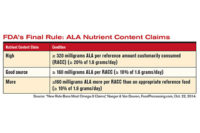Why I Still Buy Baby Food: It's the Omega-3s

Source: Lycored
These long-chain omega-3 fatty acids serve as primary building blocks for the brain and the eyes and support brain, eye and cardiovascular health, among other potential benefits under investigation, throughout life. They are either derived from fish or algae, and are the only omega-3s that FDA allows for a qualified health claim.
They are naturally present in the two fatty fishes (salmon and tuna) that I consume, but not as often as I should. And unfortunately, my sons and husband believe if it has fins, it should swim away.
I purchase a number of alpha-linolenic acid (ALA)-rich foods, including eggs and various grains. But the deal with this plant-derived omega-3 is that the body must first convert it to DHA and EPA in order to reap the health and wellness benefits. Not all bodies convert ALA very efficiently, so there’s no guarantee that eating ALA means you are benefitting from DHA and EPA.
I am armed with the knowledge that scientific evidence shows that people of all ages, from infants to aging adults, benefit from an adequate supply of DHA and EPA in the diet. Yet despite its importance, Americans have among the lowest dietary intakes of omega-3s in the world.
Now Stonyfield Farm, Londonderry, N.H., recently rolled out Stonyfield Organic Omega-3 Milk (see new product section for a detailed description), and a number of other value-added milk marketers offer similar fluid options. But as much as my household loves milk, we also want other options.
One of the first products in the U.S. to be enriched with DHA was infant formula - just in time for my first born. Of course I spent the few extra dollars for the promise of better brain development in both of my babies. (I will add that it has paid off. Both had straight A’s this past school year.) The natural transition from infant formula to milk makes dairy the leading delivery vehicle for these critical fatty acids, which is why value-added milk processors are having success with their omega-3 options.
But the rest of us need more options, and I prefer my family gets their essential nutrients from food not a capsule.

Source: AKFP
For those of us who are a bit older, DHA and EPA have been shown to help prevent age-related blindness. (I recently started wearing reading cheaters!) DHA and EPA are also key components of the heart muscle. Supplementation has been shown to improve blood lipid profiles and reduce blood pressure, both of which impact heart health. (Heart disease runs in my family.)
Finally, as mentioned, DHA is a major structural fatty acid in the brain. A large observational study published in the December 2004 issue of the American Journal of Clinical Nutrition indicates that intake of DHA, and especially the ratio of omega-3 to omega-6 fatty acids, independent of childhood IQ, is important in the retention of cognitive function later in life. (I am always misplacing my car keys!)
According to a study published in the November 2006 issue of Archives of Neurology, people with the highest level of plasma DHA had a significant (47%) reduction in the risk of developing dementia from any cause. After nine years of follow-up, subjects with the highest levels of plasma DHA were less likely to develop Alzheimer’s disease.
So, before I forget to remind you, dairy foods are an ideal delivery vehicle for DHA and EPA, among many other critical nutrients. Please make me a power-packed product that my family and I can enjoy.
Looking for a reprint of this article?
From high-res PDFs to custom plaques, order your copy today!







